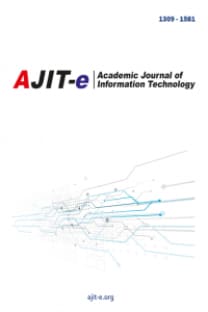Sağlık Bilgi Sistemi Değişim Direnci Değerlendirmesi
Assessment of Health Information System Change Resistance
Change Resistance, Health Information Systems,
___
Backroad Connections Pty Ltd. (2004). Approaches to Change Management for Flexible Learning (Version 1.02),. Australian Flexible Learning Framework Quick Guides series, Australian National Training Authority.Banova B. (2018).The impact of technology on healthcare. American Institute Of Medical Sciences. http://www.aimseducation.edu/blog/the-impact-of-technology-on-healthcare /(accesed January 2020) Brandon B.(2007) The eLearning Guild's Handbook of e-learning Strategy, The eLearning Guild. Street,Suite 200Santa Rosa,CA 95404
Edelstein P. (2017).Top trends in health information & communications technology for 2017, http://www.elsevier.com/connect/top-trends-in-health-information-and-communications-technology-for-2017 (accesed December 2019)
Javanparast S, Maddern J, Baum F, et al. (2017). Change management in an environment of ongoing primary health care system reform: A case study of Australian primary health care services. Int J Health Plann Mgmt. https://doi.org/10.1002/hpm.2413.
Kaminski, J. (2011). Diffusion of Innovation Theory Canadian Journal of Nursing Informatics, 6(2). Available at: http://cjni.net/journal/?p=1444 (accesed May 2019).
Kilian M. Bennebroek Gravenhorst. (2003). A Different View on Resistance to Change”, Paper delivered at the “Power Dynamics and Organizational Change IV” Symposium at the 11th EAWOP Conference in Lisbon, Portugal, 14-17 May 2003
Mackenzie-Robb. LE-(2004.).learningand Change Management – The Challenge.
Maguire, D and Honeyman, M. (2018). Digital change in health and social care Digital health and care congress July 2018. http://www.kingsfund.org.uk/sites/default/files/20180*6/Summary_digital_change_, health_care_Kings_Fund_June_2018.pdf (accesed May 2019).
Mulholland B. (2008). Critical Change Management Models to Evolve and Survive http://www.process.st/change-management-models/ (accesed April 2019)
Navid,P,Slusky,L. (2009). Challenges of Change Management in E-learning (Distance Learning), Encyclopedia of Distance Learning, Second Edition.. (4 Volumes)
Parlakkılıç, A. (2014). Change Management In Transition To E-learning System. Qualitative and Quantitative Methods in Libraries (QQML) 3:637 –651,
Pugh, L.(2007). “Change Management in Information Services. Asghate Publishing Limited, Aldershot
Rick T. (2013).Change Is Not The Problem – Resistance To Change Is The Problem http://www.torbenrick.eu/blog/change-management/change-is-not-the-problem-resistance-to-change-is-the-problem/ (accesed March 2020)
Rogers, E. M. (2003). Diffusion of innovations. New York: Free Press
Saluvan, M., & Ozonoff. (2018). A Functionality of hospital information systems: results from a survey of quality directors at Turkish hospitals. . BMC medical informatics and decision making, 18(1), 6.doi:10.1186/s12911-018-0581-2
Shepherd, Mary Lohse et al. (2014). Using the Awareness, Desire, Knowledge, Ability, Reinforcement Model to build a shared governance culture. http://www.vantaggio- learn.com/White%20papers/VantaggioCM.pdf (accesed March 2020).
- Yayın Aralığı: 4
- Yayıncı: AKADEMİK BİLİŞİM ARAŞTIRMALARI DERNEĞİ
Sağlık Bilgi Sistemi Değişim Direnci Değerlendirmesi
Alaattin PARLAKKILIÇ, Nevzat ÜNALAN
Türkiye’deki İlk 5 Kategori için Instagram Fenomenleri Analizi
Busra ERTOGRUL, Gizem KİLİCSİZ, Aysun BOZANTA
Büyük Veri (Big Data)’nin Yapay Zekâ Uygulamalarında Toplumsal Sınıflandırmaya Yönelik Kaygılar
